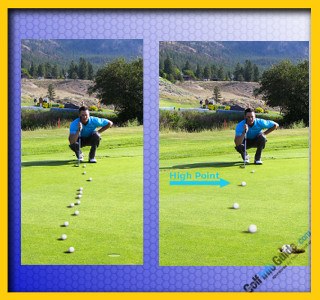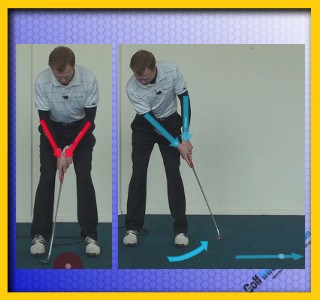 Every golfer knows how exquisitely frustrating putting can be. There are so many ways to miss a putt, and so very few ways – really only one – to sink it! Everything needs to be pretty close to perfect to get the ball into the hole – your read of the putt, the mechanics, your concentration and visualization, and the stroke.
Every golfer knows how exquisitely frustrating putting can be. There are so many ways to miss a putt, and so very few ways – really only one – to sink it! Everything needs to be pretty close to perfect to get the ball into the hole – your read of the putt, the mechanics, your concentration and visualization, and the stroke.
Putting is frustrating also for another reason: because losing a stroke (or more) on the green can negate some of the fantastic work you did getting to the green!
Here are five tips that should result in fewer putts (and less frustration).

1. When you begin to read the green in preparation for making your putt, don’t just stand behind the ball. Instead, walk around the ball and toward the hole, “reading” both with your eyes and with your feet the slope and contours affecting the line of your putt. Then, when you return to standing behind the ball, you’ll have a better understanding of the probable movement of the ball as it rolls toward the hole.
2. If your putt is twenty feet or longer, focus as much on distance as on pinpoint accuracy. While obviously you wish to sink those long putts, just as important is avoiding the three-putt! One way of improving your ability to putt the correct distance is by using the following practice drill. On a practice green, try several putts from twenty, thirty, or forty feet. However, instead of attempting to sink the putts, simply try to place the balls within three feet of the hole. This drill should train you to keep the ball within two-putt range on long putts.
3. Try limiting your backstroke to a quarter-distance and using a three-quarter distance stroke on your follow-through.The objective is to keep your backstroke short and compact, and then to guide the ball with a long, deliberate forward stroke. Remember, the shorter your backstroke, the easier it is to keep the club face straight and to fully control your forward stroke.

4. Stroke through the ball; don’t hit it. (This is closely connected with the previous point.) If the ball jumps a little when you make contact, you know you’re hitting it – which is the wrong technique. Think of pushing the ball forward rather than striking it. You can experiment on the practice green by closing your eyes when you stroke the putt. Since you don’t know precisely when the club head will make contact with the ball in this situation, you’ll be less likely to hit and more likely to stroke.
5. Visualize the whole putt before you begin the stroke. Apparently Jack Nicklaus visualized every shot – on tee, fairway, or green – before making the stroke. Then keep the visualization in mind as you begin your stroke. This is the perfect way to focus all your concentration on the shot. It doesn’t mean that you’ll sink every putt, but it means that you’ll take your best shot every time.
However well you play on the tee and on the fairway, you won’t be a complete golfer until you learn to putt consistently and well. These tips should enhance your putting and take some of the frustration out of your golf experience.
Improving your putting is crucial for lowering your golf scores. Here are five tips to help you become a better putter:
- Develop a Consistent Putting Routine: Establishing a consistent and repeatable putting routine is essential for building confidence and consistency on the greens. Your routine should include elements such as visualizing the line, taking practice strokes, aligning your putter face and body, and maintaining a steady tempo. Stick to this routine for every putt to create a reliable and repeatable process.
- Focus on Distance Control: Distance control is vital for sinking putts consistently. Spend time on the practice green working on your feel and touch. Practice different length putts and focus on getting a sense of how far the ball rolls with various stroke lengths. This will help you develop a better feel for speed and distance control on the greens.
- Read the Green Effectively: Improve your ability to read greens by paying attention to subtle slopes, grain, and the overall contour of the putting surface. Take your time to analyze the line and visualize the path the ball needs to take. Look for any visual cues such as changes in color or surrounding landmarks that can assist in your read. Practice reading greens during your rounds to refine your skills.
- Keep Your Head Still: One common putting mistake is lifting or moving your head during the stroke. This can lead to inconsistent contact and misalignment. Focus on keeping your head steady and still throughout the stroke. Maintain your posture and keep your eyes fixed on the ball until well after impact.
- Practice with Purpose: To improve your putting, you need to dedicate time to practice. Make sure your practice sessions have a specific focus and purpose. Work on different aspects of putting, such as alignment, stroke mechanics, and distance control. Incorporate drills and games into your practice routine to make it more engaging and effective.
Remember, consistency and patience are key when working on your putting. It takes time and practice to see improvements. Be diligent in your efforts, stay positive, and maintain a growth mindset. Working with a golf instructor or coach can also provide valuable guidance and feedback tailored to your specific needs.





